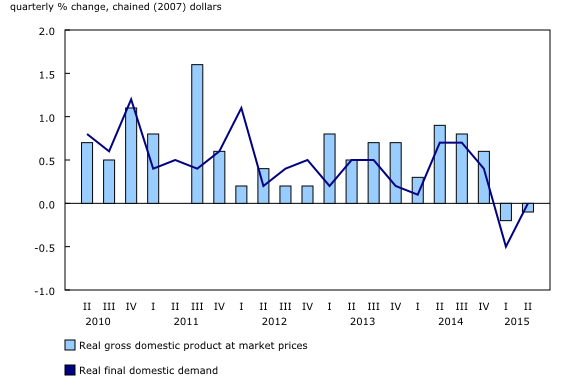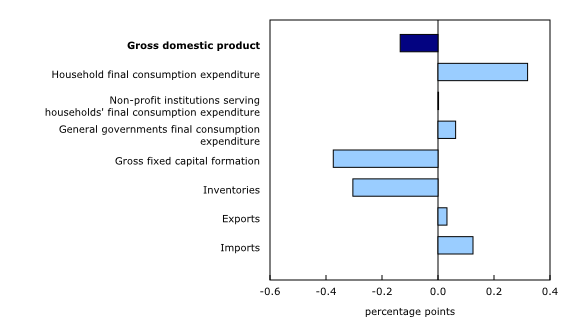Gross domestic product, income and expenditure, second quarter 2015
Archived Content
Information identified as archived is provided for reference, research or recordkeeping purposes. It is not subject to the Government of Canada Web Standards and has not been altered or updated since it was archived. Please "contact us" to request a format other than those available.
Released: 2015-09-01
Real gross domestic product (GDP) declined 0.1% in the second quarter, following a 0.2% decrease in the first quarter. On a monthly basis, real GDP by industry rose 0.5% in June.
Final domestic demand was flat after declining 0.5% in the first quarter.
Business gross fixed capital formation decreased 2.0%, the second consecutive quarterly decline. Lower business investment in non-residential structures and machinery and equipment (-3.1%) were the main contributors to the decline. Other factors contributing to the decrease included a 4.1% decline in new housing construction and a 33.2% drop in business outlays on mineral exploration and evaluation.
Household final consumption expenditure rose 0.6%, following a 0.1% gain in the first quarter. Increased spending on durable goods and semi-durable goods more than offset decreased spending on non-durable goods. Outlays on services were up 0.8%.
Inventory accumulation slowed in the second quarter as businesses added $7.1 billion worth of goods to inventories, down from the $12.1 billion added in the first quarter.
Exports of goods and services edged up 0.1% after decreasing 0.3% in the first quarter. Exports of goods were 0.2% higher while services fell 0.3%. Imports of goods and services were down 0.4%.
From an industry perspective, the value added of goods-producing industries decreased 2.0% in the second quarter, while that of service industries rose 0.6%.
The mining, quarrying and oil and gas extraction sector (-4.5%) posted a notable decrease, down for a second consecutive quarter. The decrease was mostly a result of the decline in the non-conventional oil extraction industry (-5.7%), which experienced maintenance shutdowns and production difficulties in the second quarter. Support activities for mining, oil and gas extraction (-18%) declined for the second consecutive quarter. Manufacturing, construction and utilities also declined in the second quarter.
On the other hand, the output of real estate agents and brokers (+9.9%) as well as wholesale trade (+1.4%) posted notable increases. The finance and insurance sector and retail trade also rose, while the public sector (education, health and public administration combined) edged up.
Expressed at an annualized rate, real GDP contracted 0.5% in the second quarter and 0.8% in the first quarter. By comparison, real GDP in the United States grew 3.7% in the second quarter.
Business investment in plant and equipment falls
Business investment in non-residential structures decreased 2.3% in the second quarter, the third consecutive quarterly decline. Lower investment in both non-residential buildings (-1.8%) and engineering structures (-2.4%) contributed to the decline.
Investment in machinery and equipment by businesses fell 4.6% in the second quarter. Lower investment in industrial machinery and equipment (-11.6%), communications and audio and video equipment (-4.7%) and furniture, fixtures and prefabricated structures (-3.0%) contributed to the decline.
Investment in intellectual property products declined 4.6% in the second quarter, following a 5.0% decrease in the first quarter. Business outlays in mineral exploration and evaluation fell 33.2% in the second quarter, after decreasing 19.6% in the first quarter.
Investment in housing slows
Following a 0.9% increase in the first quarter, business investment in residential structures grew 0.3% in the second quarter. A decrease in new housing construction (-4.1%) was mitigated by an increase in renovations (+0.3%) and ownership transfer costs (+10.4%), indicating continued strength in housing resale activity.
Household spending increases
Household final consumption expenditure increased 0.6% in the second quarter, following a 0.1% gain in the first quarter. Consumers increased spending on goods by 0.3%, led by durable goods (+1.6%), while services grew 0.8%.
Transport purchases (+1.5%) contributed the most to the growth in household final consumption, boosted by a 2.9% increase in purchases of vehicles. Outlays on insurance and financial services (+1.2%) and food, beverage and accommodation services (+1.2%) also contributed to the growth in household spending. Electricity, gas and other fuels declined 4.6%, the largest decrease since the fourth quarter of 2011.
Business inventory accumulation falls
Businesses added $10.2 billion to non-farm inventories in the second quarter, down from $14.3 billion in the first quarter.
Inventories of retailers rose, mainly as a result of the increased inventory accumulation of motor vehicles (+$4.5 billion). Wholesalers' inventories rose $6.1 billion in the second quarter, reflecting a buildup of non-durable goods (+$4.7 billion). Manufacturers' inventories of durable goods increased $1.5 billion while non-durable goods declined $1.4 billion. The stock-to-sales ratio increased from 0.733 in the first quarter to 0.743 in the second quarter.
Farm inventories declined $1.7 billion, the sixth consecutive quarterly decrease.
Exports edge up
Exports of goods and services edged up 0.1% in the second quarter, following two quarters of decline.
Goods exports were up 0.2%, following a 0.5% decline in the first quarter. Exports of motor vehicles and parts increased 4.7%, led by tires, motor vehicle engines and motor vehicle parts (+11.2%), as were exports of crude oil and crude bitumen (+3.3%). Exports of consumer goods (+1.8%) also contributed to the increase. Declines were recorded in intermediate metal products (-3.4%) and metal ores and non-metallic minerals (-7.9%).
Exports of services fell 0.3%, compared with the first quarter gain of 0.6%. Exports of transportation services (-3.3%), commercial services (-0.6%) and general governments services (-1.4%) contributed to the decrease. Travel services exports increased 3.1%.
Imports decline
Imports of goods and services fell 0.4%, following a similar decline in the first quarter.
Imports of goods were down 0.3%. Industrial machinery, equipment and parts (-6.6%), metal and non-metallic mineral products (-6.3%), energy products (-8.5%) and electronic and electrical equipment and parts (-4.4%) contributed the most to the decrease. On the other hand, imports of motor vehicles and parts increased 8.1%.
Services imports fell 0.8%, following a 0.9% decline in the first quarter. Lower imports of commercial services (-1.7%) and transportation services (-1.1%) contributed to the decrease. Travel services (+0.8%) and general governments services (+0.4%) increased.
Slightly weaker terms of trade
Canada's terms of trade (-0.1%) declined for the fifth quarter in a row, as rising import prices slightly outpaced increasing export prices. Real gross domestic income declined 0.2% in the second quarter, compared with a 1.2% drop in the first quarter.
Export prices increased 0.4% while import prices grew 0.5%. The overall price level of goods and services produced in Canada grew 0.4% after two quarters of decline.
The price of final domestic demand grew 0.3%, following a 0.6% increase in the first quarter.
Growth in labour compensation slows
Nominal GDP grew 0.2% in the second quarter, after decreasing 0.6% in the first quarter.
Compensation of employees edged up 0.1%, following a 1.2% gain in the first quarter which was boosted by a special contribution to the federal government pension fund. Excluding employers' social contributions, the wages and salaries component of labour compensation increased 0.3%.
After two consecutive quarters of decline, wages and salaries were up 0.3% in goods-producing industries, mainly attributable to the manufacturing and construction industries. Growth in wages and salaries in service-producing industries slowed from 1.3% in the first quarter to 0.4% in the second quarter.
The gross operating surplus of non-financial corporations decreased 0.8%, a third consecutive quarter of decline. That was partially offset by a 2.7% increase in the gross operating surplus of financial corporations. Overall, the gross operating surplus declined (-0.3%) for a third quarter in a row.
Household saving rate declines
The household saving rate decreased from 5.2% in the first quarter to 4.0% in the second quarter, as household final consumption expenditure (nominal terms) increased while household disposable income declined.
The household debt service ratio, defined as household mortgage and non-mortgage payments divided by disposable income, was 14.07%, up from 13.90% in the first quarter.
The second quarter national saving rate was 2.9%, down from 3.6% in the first quarter, slowing for a third consecutive quarter. Higher corporate savings were mainly offset by lower savings of households.
Note to readers
For information on seasonal adjustment, see Seasonally adjusted data – Frequently asked questions.
Percentage changes for expenditure-based statistics (such as personal expenditures, investment, exports, and imports) are calculated from volume measures that are adjusted for price variations. Percentage changes for income-based and flow-of-funds statistics (such as labour income, corporate profits, mortgage borrowing and total funds raised) are calculated from nominal values; that is, they are not adjusted for price variations.
There are two ways of expressing growth rates for gross domestic product (GDP) and other time series found in this release.
1. Unless otherwise stated, the growth rates in this release represent the percentage change in the series from one quarter to the next, such as from the first quarter of 2015 to the second quarter of 2015.
2. Quarterly growth can be expressed at an annual rate by using a compound growth formula, similar to the way in which a monthly interest rate can be expressed at an annual rate. Expressing growth at an annual rate facilitates comparisons with official GDP statistics from the United States. Both the quarterly growth rate and the annualized quarterly growth rate should be interpreted as an indication of the latest trend in GDP.
Next release
Data on gross domestic product by income and by expenditure for the third quarter will be released on December 1.
Products
Data on gross domestic product for the second quarter have been released along with revised data for the first quarter. These data incorporate new and revised source data and updated data on seasonal patterns.
The article "Household debt service ratio–Interest and principal," which is part of the Latest Developments in the Canadian Economic Accounts series (13-605-X) is now available from the Browse by key resource module of our website under Publications. This article describes the new quarterly estimates of household sector debt payments (mortgage and non-mortgage), including both the interest and principal components.
The publication Canadian Economic Accounts Quarterly Review (13-010-X) has been discontinued. Links to other releases from the national accounts can still be found on the System of macroeconomic accounts module, accessible from the Browse by key resource module of our website.
The 2015 comprehensive revision to the gross domestic product, income and expenditure will be released with the third quarter estimates, on December 1. Additional information is available in the article "A preview of the 2015 comprehensive revision of the Canadian System of Macroeconomic Accounts."
Contact information
For more information, or to enquire about the concepts, methods or data quality of this release, contact us (toll-free 1-800-263-1136; 514-283-8300; infostats@statcan.gc.ca) or Media Relations (613-951-4636; statcan.mediahotline-ligneinfomedias.statcan@canada.ca).
- Date modified:





